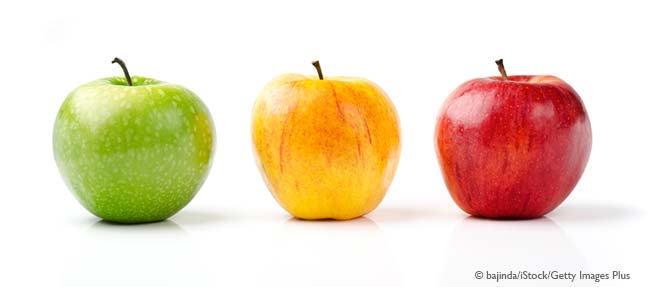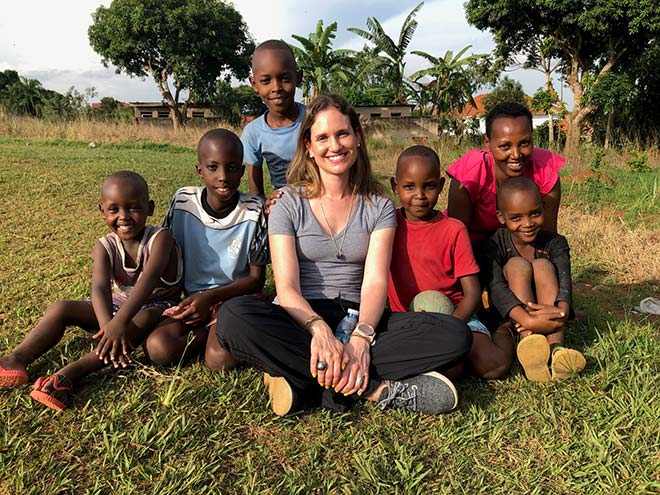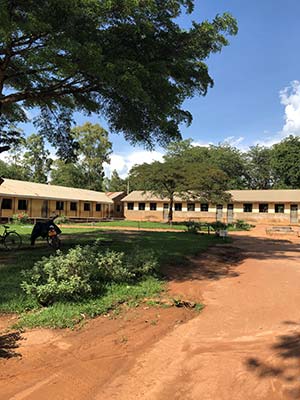Meet the Multiplier Effect
If you had three apples and two hungry children, what would you do?
You might split the extra one and dole out the fruit equally. Or maybe take a hands-off approach and let the kiddos work it out.

That’s not what Paulina Restrepo-Echavarria would do. As a senior St. Louis Fed economist who has studied everything from sovereign debt to the legacy of Bretton Woods, she’s interested in the decision that maximizes output.
She also has two curious kids with tons of energy.
So when her daughter recently asked her, what do you do at work?, she used the apple example to explain her livelihood—as well as the impact people can make by considering how one’s choices to consume, invest or even give can be magnified.
I had the pleasure of sitting down with her to learn how. Here’s an excerpt of our conversation.
The apple quandary: what’s a parent to do?
Christine: Paulina, I know that you have two young children. Your daughter recently asked you, “What does an economist do?”
How do you explain to a young child what an economist does?
Paulina: Yes, it’s very hard to explain because she knows that I work for a “bank.” So in her mind, it’s like being a bank teller.
She did come up with that question the other day. What I tried to explain to her is, we think about the ultimate allocation of resources. That’s what we want to do. We want to do our best so that growth is as high as possible.

St. Louis Fed Senior Economist Paulina Restrepo-Echavarria pictured with her two children and their furry friend.
But for her, obviously, that’s very hard to grasp. So I said to her:
Imagine that I have three apples, and I want to distribute three apples between two kids. I know that there’s one kid who is definitely going to eat as many apples as I give them. Then, I know that there’s another kid who will eat only one of the apples—and if I give him or her any extra apples, they will plant them so that the seeds produce another apple tree … and then more apples grow out of that tree. So, what is the optimal thing for me to do as an economist?
She said, “Well, I don’t know. Give the apple to the kid that is going to eat them because he’s hungry, probably?”
Like, yeah, you’re right, but you know one apple is enough to calm your hunger.
What I would do is actually give only one apple to the kid who would eat all the apples. Then, I would give the other two apples to the kid who would eat one and plant the other one.
Because that means that in a while from now, when the kid plants the seeds of the apple and the tree grows, we’re going to have more apples than we had before.
If I give the apples to the kid who eats them all, then in the future, we’ll have no apples. He will just eat them. They won’t multiply.
So, that’s a very clear example of what we try to do as economists. We try to allocate resources in such a way that we maximize overall output. That was my explanation to her.
In a nation’s economy, decisions can be magnified
Speaking of maximizing output, the term “multiplier” is commonly referenced in relation to gross domestic product. GDP factors in consumer spending on goods and services; private investment; government purchases; and net exports (that is, exports minus imports).
Say the federal government wants to stimulate the economy. It might try to do so with an increase in spending — a stimulus package.
In theory, it works like this: The initial increase in government spending has a direct effect on GDP. But it also sets off a chain of additional spending throughout the economy:
- dollars spent in one place are received as income elsewhere
- some of that income gets spent and received as income elsewhere
- then some of that income gets spent and … you get the idea
While this flow diminishes with successive rounds, the impact of the initial increase in government spending has been magnified. The “multiplier effect” describes this dynamic.
Paulina explained how you might observe this at a high level.
Christine: The multiplier effect: I did want to ask a follow-up on that. Tell me how you see that exhibited when it comes to a nation’s economy or a regional economy. How does the multiplier effect manifest itself in a way that an adult would notice?
Paulina: So, that’s the difference between consumption and investment.
We think about a closed economy, and the GDP of that closed economy is going to be distributed between:
- Consumption
- Investment
- Government spending
Those are the three components.
If we’re thinking about an open economy, we know that GDP is equal to consumption plus investment plus government spending — plus net exports.
When you’re deciding what to do with GDP in your country, you can either consume it or you can save it and invest it and produce more next period. So, savings in an economy would reflect that.
Of course, it’s way trickier; that doesn’t mean I’m saying that the optimal thing is to save.
But we do see economies that are a great example of that. China is a great example of that. China is a country that is a big saver, and we know they’re growing very fast.
However, it’s not the only way to grow. Because the real economy is much more complicated than just eating apples and planting apples.
But that’s the analogy when you put it in the real-world context: consume or invest.
How donors and nonprofits can maximize their impact
The multiplier effect doesn’t just apply to government spending.
For instance, if businesses invest in more equipment, or people buy more houses (both of which fall under the “private investment” bucket of GDP), that also triggers a chain reaction.
Same with a change in consumer spending. An increase in our spending can ripple throughout an economy.
But what about dollars we donate? Might there be ways to multiply or magnify the impact they make?
Christine: There’s another related question. As I look at my limited dollars and my limited time, and I’m feeling particularly charitable, I want to allocate a certain amount of that to organizations that I believe are doing good work around the world.
In your own life, you’ve done a lot of charitable work, including with an organization in Uganda that strives to lift children out of poverty.
How can nonprofits exhibit the multiplier effect, so that donor dollars or donor time can have a bigger impact?
Paulina: It’s exactly in the same way. There are two dimensions to this question:
- One is, how do I decide how to allocate the extra resources that I have when it comes to choosing an organization to give?
- And then, what should an organization do in terms of multiplying that?
In my case, as you mentioned, I help a foundation called Fields of Dreams Uganda. This foundation is to help out orphaned children in Uganda through the vehicles of soccer and education.
Kids are particularly fond of soccer in Uganda. If they know that they can play soccer at school, it’s more likely for them to stay in school. They are going to be happier, and so on.

Restrepo-Echavarria traveled to Uganda in 2019 to help the nonprofit Fields of Dreams Uganda, which provides hope to orphaned and vulnerable children through the vehicles of soccer and education.
I like soccer very much, so clearly that was one of the reasons why I chose this foundation. But there was another reason: It is, when you think about where to put your money, you want to know that it’s being put to good use. And something that I dislike about many foundations or organizations is that a lot of the money goes to cover administrative costs.
So the multiplier, as you pointed out, is going to be smaller.
This organization that I help out, to give you an example, there’s only one person in the U.S. who has a salary that is paid out of the foundation. The rest of the staff of the foundation are local people in Uganda who get a salary.
But there, the multiplier is much more important because these are people that, if it wasn’t for the foundation, maybe they wouldn’t have a job. The fact that the foundation is paying for them—local people—means they can then go out and consume.
Because they go out and consume, then the people they buy groceries from, for example, are going to be able to buy their own food. So, the multiplier goes through there. That’s an important thing.

Part of the campus managed by Fields of Dreams Uganda, which cites the importance of education for lifting children out of poverty.
Now, the other thing that is very important about the foundation, or that really drove me to them, is that they think about the multiplier also in terms of what they do with the resources that they’re using.
To give you an idea, there’s a feeding program. There are kids that, unfortunately, have no food when they go to school.
Families are meant to bring an endowment of, let’s say, beans at the beginning of the school year.
Imagine that they have to bring to school 5 kilos of beans. And if they don’t have the resources to bring those 5 kilos of beans at the beginning of the school year, then they’re not going to be fed on a daily basis. They’re going to have classmates, other kids, who are given their portion of food at lunch. Some kids are going to have to sit there with them, starving.
The foundation gives food for these kids who don’t have the means to bring the endowment at the beginning of the year.
The multiplier part — or the sustainable part — that they’re doing is this: At the same time that they’re setting that feeding program, they are planting gardens in the schools so that the parents of the kids can harvest them.
At some point, those plantations become “self-sustainable” in the sense that they’re producing enough money to feed all the kids in school, such that there’s no inequality in terms of the kids who can bring the 5 kilos of beans versus those who cannot bring them.
In the long run, that makes a feeding program sustainable.
It’s exactly the same thing with the apple. You are, instead of just giving them food to consume, solving that issue — which is hunger, which is immediate, and you have to solve it. But they're also planting these gardens in the schools to make them sustainable in the long run, such that no one has to bring food to school from their homes.
Additional Resources
This blog explains everyday economics and the Fed, while also spotlighting St. Louis Fed people and programs. Views expressed are not necessarily those of the St. Louis Fed or Federal Reserve System.
Email Us


